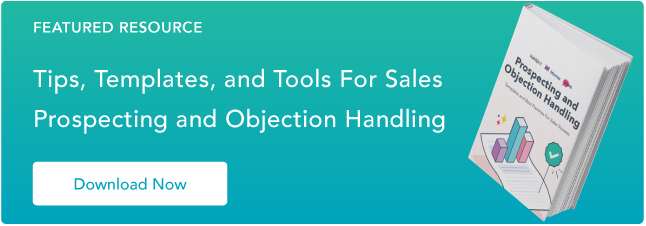Sales resistance is one of the most fundamentally ingrained and constantly frustrating elements of sales. And it can come from a lot of sources — here are a few of the most common ones you can expect to run into during your sales career.
Prospects are skeptical of your offering, your company, or you.
Some sales calls can be sketchy for prospects. Odds are, they're not going to have an intimate understanding of your business or your solution. And you can't exactly bank on them trusting you, right out of the gate.
This point is particularly pertinent if your solution is relatively new or unique. Consumers rely on other consumers to validate their preferences and decisions to assume risk.
If you don't have a solid base of customers to vouch for how awesome, effective, and legitimate your product or service is, you might find yourself in a bit of a pinch.
The idea of being the first customer to boldly go where no business has gone before generally isn't attractive to your average prospect. So if you don't have a vocal, enthusiastic base to offer your solution some clout, you might run into some resistance.
Prospects are reluctant to shake things up.
Inertia can be one of the tougher roadblocks to figure out. If a prospect is content with the solution they're leveraging, what do they need you for? They might have established relationships with contacts who work at your competition. They might feel they don't have time to learn and implement your solution. Or they might be resistant to change in general.
Prospects who are stuck in their ways are particularly difficult to sway, and when you're talking to them, you're at a major disadvantage. It's not just that you have to convince them that your product or service is the best one for their business — you have to show them that it's so much better than their current solution that they should go out of their way and fundamentally alter their current operations to leverage it.
People often push back on putting in that kind of effort — particularly when they're not sure it's necessary. That can make for some serious resistance from prospects.
Prospects don't like your sales process.
Sales resistance doesn't always stem from problems or concerns your prospects have with your product or service. Sometimes, prospects will get testy with you because they don't like how you're selling to them.
Your messaging might rub them the wrong way. The frequency of your outreach might be too often or too scarce. It could just be that your company's approach to certain steps in your sales process doesn't suit their interests or sensitivities. That makes for a unique kind of resistance — one where the prospect winds up pushing back on you as opposed to your product or service.
Prospects don't want to choose any solution for fear of making a mistake.
Some prospects aren't reluctant to embrace your solution so much as they're reluctant to embrace any solution. This kind of resistance can be particularly frustrating. These prospects are so afraid of making a mistake that they refuse to make a choice at all.
This point can put a lot of sales into a limbo that ultimately turns potential deals into non-starters. Most people are naturally risk-averse, and that tendency gets even stronger when they're faced with making a big purchase on behalf of their company.
How to Overcome Sales Resistance
1. Cut the clichés
Most sellers open their calls with clichés, immediately turning off their prospects.
These are the most buyer-repellent statements I hear in my coaching work:
- How are you today?
- Is this a good time to talk?
- Could I have a few minutes of your time?
- I was wondering if maybe you would be interested in …
- This is (name) and I’m calling to tell you about … (followed by a 2-minute monologue)
- I'll only take a minute of your time.
- I'd like to talk to you about …
- I think that I can …
- Are you looking for ways to become more profitable?
- I have a product that can save you money.
- I’m in the business of making our customers more successful.
- I create partnerships with our buyers to help them save money on …
- I want to show you how we would help you …
- I know we can save you time and money.
Cutting the sales-y statements will instantly increase your success rate by not naturally generating resistance. This is especially true for the ubiquitous, “How are you?"
Every buyer on the planet has heard that exact phrase at the beginning of a sales call they didn't want to take. After my clients stop using this question on calls, they typically see a 25% jump in success.
When you call, your buyers are usually busy doing other work — which means you're 99.9% likely to be interrupting them. Instead of ignoring this fact, use it to your advantage.
Try"Mary? This is Colleen Francis. I know you weren’t expecting my call; have I caught you at a bad time?"
When it comes to receiving a sales call, it's always a bad time, so it’s a refreshing change when the person who's making the call recognizes this upfront.
When we use this statement at the beginning of a call, we almost always get the same answer: A laugh or chuckle, followed by either: "It's always a bad time, but what's up?" or"Sure it's a bad time, why are you calling?"
The magic in this answer is that now it is the buyer's choice that you're on the phone with them — not yours. When a buyer feels like they're being held hostage in a conversation, they tune out and start planning their escape. When it's their choice the two of you are talking, however, they're far more likely to listen to what you have to say and participate.
2. Let them know you have experience with similar businesses.
In many cases, a prospect's resistance is born out of suspicion. They hardly know you — if at all. Why on Earth should they trust you? They've never leveraged your solution. How can they possibly know whether it's right for their business?
A conversation with a prospect with those questions at top of mind is an uphill battle. You're at a disadvantage because they're absolutely right. It's perfectly justified for them to be skeptical of what they might feel is some random company on the other side of a sales call.
So you're confronted with a dilemma: How can you convey the benefits their business — specifically — can expect to see by leveraging your solution? Well, one way is to reference how your product or service has helped similar businesses.
See if you can describe how their industry peers or businesses of similar scale and structure have seen considerable success with your offering. There's no guaranteeing results for your prospect, but giving them some appropriate context about what they can probably expect as a result of doing business with you is the next best thing.
3. Switch your focus
Sales calls are about the buyer — not about you. If the buyer hears the word "I" first, they think, “Who cares what you want? What about me?”
Your buyer is focused on what's in it for them, so give it to them right up front.
Try some of the following ideas:
- If you're calling because of a referral, use the reference's name first, as in: "Colleen Francis suggested we talk."
- If it's a follow-up call, remind them what they wanted you to do: "The last time we spoke, you asked me to call today with pricing information."
- If this is an outreach call and you don’t have a reference, build a third-party story focused on people like your buyer, such as: "CIOs like yourself have been pleased with the security our product offers from email viruses. They've told me that … Is that important to you?"
- If you don't know who you should be talking to, try a question, like: Maybe you can help me?" People usually have a difficult time refusing help when they're asked for it, so make sure you use that word.
- If you reach the gatekeeper of a client you've had a hard time contacting, try:"Maybe you can help me? I've been trying to reach Ms. Francis for a week now with no luck. Do you know if there's a best time to find her in her office?"
4. Drop the assumptions
Be careful about making broad claims — buyers who don’t know you will instinctively poke them for holes.
Many will react with:“You don't even know me. How do you know you can do that? You have no idea what you're talking about, so I'm going to argue with you and then get rid of you.”
Replace assumptive language with examples and questions, such as:
"Mary, business owners like you tell me that we've been able to save them money on their printing costs. Depending on your printing requirements, it might be possible that we can do the same for you. Can we discuss your printing requirements now?"
Ultimately, you can build a relationship and avoid creating resistance by focusing on two key things going into a call:
- The buyer’s needs and goals (versus your own)
- Starting a conversation (rather than trying to sell)
These two areas will help you relax and project an open, friendly demeanor. Instead of encountering resistance, you’ll get a warm response.
Sales resistance is every bit as natural as it is frustrating. As a sales professional, you're bound to run into it at some point. Still, if you can understand where it stems from and some strategies to remedy it, you can keep it from stalling your sales efforts.
Objection Handling

.jpg)










